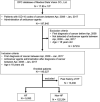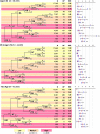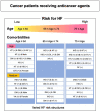Risk factor structure of heart failure in patients with cancer after treatment with anticancer agents' assessment by big data from a Japanese electronic health record
- PMID: 36705672
- PMCID: PMC10182140
- DOI: 10.1007/s00380-023-02238-9
Risk factor structure of heart failure in patients with cancer after treatment with anticancer agents' assessment by big data from a Japanese electronic health record
Abstract
As the prognosis of cancer patients has been improved, comorbidity of heart failure (HF) in cancer survivors is a serious concern, especially in the aged population. This study aimed to examine the risk factors of HF development after treatment by anticancer agents, using a machine learning-based analysis of a massive dataset obtained from the electronic health record (EHR) in Japan. This retrospective, cohort study, using a dataset from 2008 to 2017 in the Diagnosis Procedure Combination (DPC) database in Japan, enrolled 140,327 patients. The structure of risk factors was determined using multivariable analysis and classification and regression tree (CART) algorithm for time-to-event data. The mean follow-up period was 1.55 years. The prevalence of HF after anticancer agent administration were 4.0%. HF was more prevalent in the older than the younger. As the presence of cardiovascular diseases and various risk factors predicted HF, CART analysis of the risk factors revealed that the risk factor structures complicatedly differed among different age groups. The highest risk combination was hypertension, diabetes mellitus, and atrial fibrillation in the group aged ≤ 64 years, and the presence of ischemic heart disease was a key in both groups aged 65-74 years and 75 ≤ years. The machine learning-based approach was able to develop complicated HF risk structures in cancer patients after anticancer agents in different age population, of which knowledge would be essential for realizing precision medicine to improve the prognosis of cancer patients.
Keywords: Anticancer agents; Electronic health record; Epidemiology; Heart failure; Machine learning.
© 2023. The Author(s).
Conflict of interest statement
The authors declare no conflict of interests.
Figures




Similar articles
-
Machine learning optimization of an electronic health record audit for heart failure in primary care.ESC Heart Fail. 2022 Feb;9(1):39-47. doi: 10.1002/ehf2.13724. Epub 2021 Nov 23. ESC Heart Fail. 2022. PMID: 34816632 Free PMC article.
-
Heart failure and the prognostic impact and incidence of new-onset of diabetes mellitus: a nationwide cohort study.Cardiovasc Diabetol. 2019 Jun 12;18(1):79. doi: 10.1186/s12933-019-0883-4. Cardiovasc Diabetol. 2019. PMID: 31189473 Free PMC article.
-
Electronic Phenotyping to Identify Patients with Heart Failure Using a National Clinical Information Database in Japan.Stud Health Technol Inform. 2021 May 27;281:243-247. doi: 10.3233/SHTI210157. Stud Health Technol Inform. 2021. PMID: 34042742
-
Trends in the prevalence of malignancy among patients admitted with acute heart failure and associated outcomes: a nationwide population-based study.Heart Fail Rev. 2019 Nov;24(6):989-995. doi: 10.1007/s10741-019-09808-y. Heart Fail Rev. 2019. PMID: 31175492 Review.
-
Cancer Risk in the Heart Failure Population: Epidemiology, Mechanisms, and Clinical Implications.Curr Oncol Rep. 2020 Dec 2;23(1):7. doi: 10.1007/s11912-020-00990-z. Curr Oncol Rep. 2020. PMID: 33263821 Free PMC article. Review.
References
-
- Abe R, Sakata Y, Nochioka K, Miura M, Oikawa T, Kasahara S, Sato M, Aoyanagi H, Shiroto T, Sugimura K, Takahashi J, Miyata S, Shimokawa H, Investigators C. Gender differences in prognostic relevance of self-care behaviors on mortality and hospitalization in patients with heart failure—a report from the CHART-2 Study. J Cardiol. 2019;73:370–378. doi: 10.1016/j.jjcc.2018.11.006. - DOI - PubMed
-
- Yancy CW, Jessup M, Bozkurt B, Butler J, Casey DE, Jr, Colvin MM, Drazner MH, Filippatos GS, Fonarow GC, Givertz MM, Hollenberg SM, Lindenfeld J, Masoudi FA, McBride PE, Peterson PN, Stevenson LW, Westlake C. 2017 ACC/AHA/HFSA focused update of the 2013 ACCF/AHA guideline for the management of heart failure: a report of the American college of cardiology/American heart association task force on clinical practice guidelines and the heart failure society of America. J Am Coll Cardiol. 2017;70:776–803. doi: 10.1016/j.jacc.2017.04.025. - DOI - PubMed
MeSH terms
Substances
LinkOut - more resources
Full Text Sources
Medical
Research Materials
Miscellaneous

